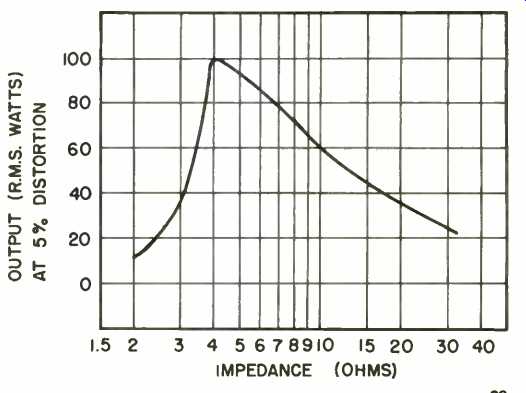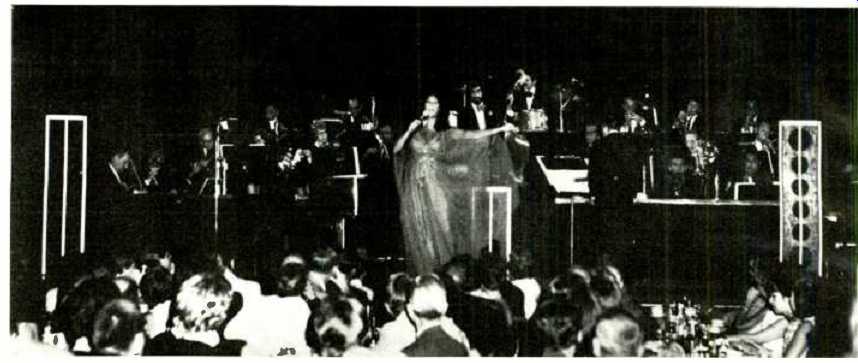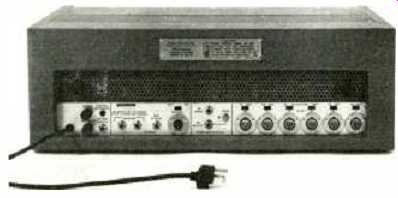By DONALD L. PATTEN /Sr. Development Engineer, Shure Brothers Inc.

-- Two column speakers on each side of stage provide coverage over
a wide horizontal area and create the illusion of source-oriented sound.
Because of loud performers, poor halls, and lots of noise and feedback, assembling a good sound system is a real challenge. Here are hints on choosing, locating, and hooking up loudspeakers and amplifiers to overcome these problems.
LAST month we discussed the various types of microphones, their placement and use, and how they are tied into the mixer /amplifier. Now we continue with the amplifier section of our system and then go into the types and use of loudspeakers in a portable sound system.
It is very important to check the impedance of the speaker load that is to be used with the power amplifier. If this point is disregarded, it is very likely that maximum output power from the amplifier will not be obtained and damage to either the speakers or amplifier, or both, may possibly occur.
For example, take the case of an all-transistor 100-watt amplifier without an output transformer, designed to operate into a 4-ohm speaker load. This amplifier, when loaded with 4 ohms, will produce 100 watts. When an amplifier is operated with its rated speaker load, it is generally operating at its maximum voltage and current output; this results in maximum power output. If this same amplifier is operated at a higher impedance load, for example 8 ohms, the available output voltage is the same, but less output current is required and the amplifier might typically produce only 60 or possibly 70 watts. If it were connected to a 2-ohm speaker load, the amplifier would operate at its maximum current capabilities trying to drive the 2-ohm load but would not be able to reach maximum voltage conditions.
Again, output power would be limited. In this case it may produce only 10 or 20 watts. (See Fig. 1.) Some amplifiers are not protected against low-impedance or short-circuited speaker loads. Such components may be damaged if operated at speaker loads less than those specified by the manufacturer. Generally, when an amplifier is operated at a lower impedance load than that recommended by the manufacturer, it will tend to overheat and may damage some of the transistors. Some amplifiers incorporate thermal switches to avoid such damage due to overheating. When the speaker load cannot be exactly matched to the recommended amplifier loading, it is generally better to use a speaker load impedance that is somewhat higher than recommended rather than one that is lower. Operating an amplifier in this way sacrifices less power (see Fig. 1) and increases reliability.
Some solid-state amplifiers employ voltage- and current-protection circuitry. This type of amplifier, while capable of producing tremendous amounts of output power to a resistive load, may not deliver the same amount of power to a highly inductive speaker load such as may be encountered with 15-inch heavy-duty cone-type speakers. Under these conditions the amplifier may "current-limit," producing a triangular-shaped output rather than flat-top clipping which is normally associated with output distortion. If this happens, the speaker load impedance should be increased by reconnecting the individual speakers in a different impedance configuration.
Speaker Phasing and Cables
Speaker and speaker-cable phasing is usually more important than microphone phasing. Proper phasing of speakers and speaker cables will insure that all speakers will work together rather than canceling out each other's efforts.
Each individual speaker in a speaker cabinet or enclosure should be checked for proper phasing with every other speaker in that cabinet. A simple method for checking the phasing of loudspeakers is to connect a 1 1/2-volt flashlight battery between the speaker cabinet terminals and noting the direction in which the speaker cones move. All cones should move in the same direction, either towards or away from the grille cloth. All speaker systems or assemblies and speaker cables should also be checked for proper phasing.
If more than one type of power amplifier is being used to drive the different speakers, it is important to check the phasing of the over-all power-amplifier/speaker system.
Depending on the number of transistors in the amplifier, phasing from the input terminals to the speaker terminals may be different for different power amplifiers. The simplest way of checking the entire speaker /power-amplifier system is to play program material, preferably with low-frequency content, or have someone talk into a microphone while another person walks through the listening or audience area, checking for dead spots between the various speaker cabinets. Should a dead zone be found, simply reverse the speaker wires at the power amplifier to change the phasing until all the speakers are in-phase.
Selection of Speakers
Sound-reinforcement speaker systems may be divided into two basic types: these are called the "distributed speaker system" and the "source-oriented speaker system." The distributed speaker system utilizes a large number of loudspeakers mounted at equidistant intervals over a large area--usually in the ceiling. Generally speaking, these speakers may be of low-power-handling capability since each individual loudspeaker is required to cover a relatively small area. The major advantage of this type of system is that it provides very uniform sound intensity over virtually any area and is ideally suited for paging and background music in such locations as airports, restaurants, hotel lobbies, and industrial plants. All of these applications require uniform coverage over large areas at relatively low levels of sound intensity. Of greatest significance, however, is the fact that these installations do not require that the listener be able to see the sound source for it to function as a good sound-reinforcement system.
A speaker system for any of the performing arts must be source-oriented to give the listener the illusion that all sound is coming directly from the actual source. Two basic speaker systems are in general use for providing source-oriented sound: one system employs both high- and low-frequency horns, the other employs speaker columns or line radiators.
The horn-speaker approach usually employs two drivers, one for low frequencies and another for higher frequencies.
The single-horn low-frequency speaker exhibits a directional characteristic that becomes less defined at low frequencies. Quite often, this non-directional pattern will lead to low-frequency acoustic feedback. Also, as the pattern becomes less directional, the total radiated energy on the listening axis of the speaker is decreased.
High-frequency horn-driver combinations can be made to have very uniform directional characteristics with respect to frequency. When used in conjunction with the low-frequency horns, a full-range system is obtained. Due to the non-directional character at low frequencies and the highly directional character at high frequencies, such a system will have an imbalance of low- to high-frequency directional characteristics. For example, when the low-frequency device is reproducing a low-frequency tone as an omnidirectional source, the on-axis intensity is low; at the same time, the high-frequency device may be operating and its on-axis intensity is high. The result will be a very "metallic" sound, exhibiting a lack of low-frequency content. Increasing the amplifier bass controls to balance the sound may cause low-frequency feedback.
The high efficiency of this type of speaker system is its major advantage over most column speaker systems, although this difference is rapidly disappearing as better column speakers are developed.

Fig. 1. Available output power of typical amplifier for various loudspeaker
loads. This particular unit has been optimized for a 4-ohm speaker load.
Other impedance values reduce available output power Where mismatch is
unavoidable, always pick higher rattle than a lower impedance.

---- The small center speaker permits the entertainer to hear herself
and provides "sound file' for the first few rows of the audience.
Column speakers located at the sides of the stage provide source-oriented
sound which covers entire room.

--- Rear view of a typical 100-watt mixer/amplifier. Loudspeakers
are plugged into jacks at left while up to six microphones can be plugged
into 3-pin Cannon-type connectors at the right. There are built-in attenuator
switches above each microphone connector.
The column speaker or line-radiator offers a number of significant advantages over the other types of speaker systems where source-oriented sound is required. The column speaker can offer high-quality reproduction at modest cost; columns are generally small, compact, and light in weight, which minimizes mounting problems and provides considerable flexibility in their placement. Narrow vertical distribution and wide horizontal distribution are characteristics of a column, which make it such an outstanding sound-reinforcement tool.
The wide horizontal front distribution pattern of a column speaker is generally the same as that of any single loudspeaker within the column; the design of the column has virtually no effect on horizontal distribution. It is the length of the column that determines the vertical angle of dispersion-the longer the column the smaller the angle.
Some column speakers use rear ports to produce a bidirectional low-frequency horizontal polar pattern. This deign reduces the omnidirectional properties which are exhibited by all speakers at low frequencies. Rather than an omnidirectional low-frequency characteristic, which might lead to acoustic feedback, the bidirectional characteristic provides a relatively "dead" area at the sides of the column, with the result that microphones may be placed there with minimal low-frequency-feedback problems.
Speaker Placement
It must be remembered that every room or space is acoustically unique and there are no set rules for speaker placement. However, a number of generalizations may be made which will at least provide a good starting point.
Always consider speaker placement in relation to microphone placement. It is desirable for the loudspeaker and microphone to be in close proximity in order to provide the illusion of source-oriented sound. It is also desirable to keep loudspeaker and microphone separated in order to achieve a high threshold of acoustic feedback. While these two statements are contradictory, a good solution can generally be found. When the column speakers are used on stage, the speakers should be placed at each side of the stage and as far forward as possible. With this setup, the entire stage area will be relatively free from acoustic feedback; also the illusion of sound coming from the center of the stage will be quite good except for those occupying the first few forward rows of seats.
Generally the stage is higher than the main audience area, therefore placing the speakers on the stage helps to project sound over the heads of the audience. If the stage is low, or a dance floor is directly in front of the stage, it may be necessary to raise the speakers by placing them on platforms or solid boxes.
Keeping in mind that the speaker columns have a narrow coverage angle in the vertical plane and a broad coverage angle in the horizontal plane, we can generalize on speaker requirements for various room shapes. A deep, narrow auditorium would generally require only two speakers if the seating is all on one level. If balconies are added to this same room, additional speaker columns would be required to aim sound up into them. A shallow, broad room might require four speakers in order to cover the entire horizontal expanse. Again if balconies are added, four more speakers might be required to expand the vertical coverage. A "theater-in-the-round" configuration will almost always require the use of at least four columns. More speakers might be required to provide adequate horizontal coverage if the theater is very deep.
To adequately cover all phases of speaker placement in all types of rooms would consume a great deal of space and still would not answer all possible criticism and arguments.
Every room is different from any other and thus correct speaker placement will vary from room to room.
Good speaker placement will provide an audience with even distribution of sound intensity, sound which is free from excessive reverberation and echoes, and the illusion of sound emanating from the real source.
Providing good sound reinforcement is an art-science requiring vast technical knowledge and a good deal of practice to become a master. However, by using the techniques we have discussed, the performer and soundman should be able to improve their performances. Good equipment is necessary, but proper use of the equipment is of greater importance. Using these guidelines as a tool, the performer must experiment with his equipment to find the particular sound he desires. In this respect, microphone placement, mixer / amplifier control settings, and speaker placement are like tuning a fine instrument. Of these, the correct placement of speakers is the hardest problem to solve. Only after a great deal of practice will you be able to make good first choices. Let the people in the audience be your judge and listen to their comments.
======
======
(adapted from: Electronics World magazine; Jul. 1975)
================